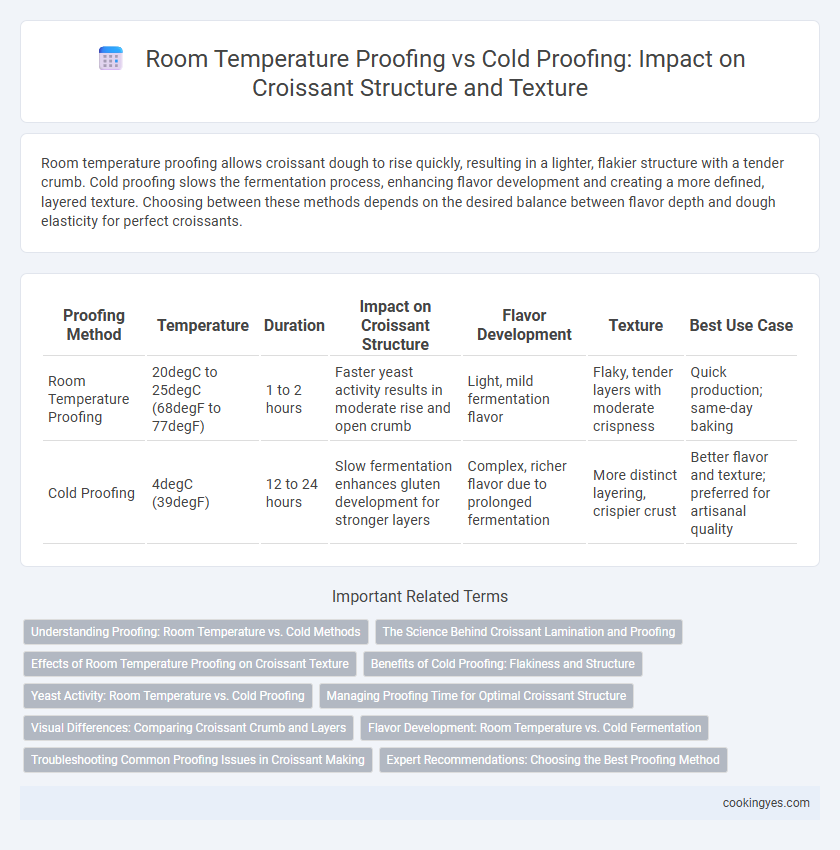Room temperature proofing allows croissant dough to rise quickly, resulting in a lighter, flakier structure with a tender crumb. Cold proofing slows the fermentation process, enhancing flavor development and creating a more defined, layered texture. Choosing between these methods depends on the desired balance between flavor depth and dough elasticity for perfect croissants.
Table of Comparison
| Proofing Method | Temperature | Duration | Impact on Croissant Structure | Flavor Development | Texture | Best Use Case |
|---|---|---|---|---|---|---|
| Room Temperature Proofing | 20degC to 25degC (68degF to 77degF) | 1 to 2 hours | Faster yeast activity results in moderate rise and open crumb | Light, mild fermentation flavor | Flaky, tender layers with moderate crispness | Quick production; same-day baking |
| Cold Proofing | 4degC (39degF) | 12 to 24 hours | Slow fermentation enhances gluten development for stronger layers | Complex, richer flavor due to prolonged fermentation | More distinct layering, crispier crust | Better flavor and texture; preferred for artisanal quality |
Understanding Proofing: Room Temperature vs. Cold Methods
Room temperature proofing accelerates yeast activity, resulting in quicker fermentation and a lighter, airier croissant structure with larger gas bubbles. Cold proofing prolongs fermentation, allowing enzymes to develop complex flavors and a more consistent, flakier lamination by slowly relaxing the gluten network. Balancing these methods influences texture, taste, and layering, crucial for achieving the ideal croissant crumb and crust.
The Science Behind Croissant Lamination and Proofing
Room temperature proofing accelerates yeast activity, promoting faster fermentation that enhances croissant lamination by generating more carbon dioxide bubbles, resulting in a lighter, flakier structure. Cold proofing slows down fermentation, allowing enzymes to break down starches and proteins progressively, which deepens flavor complexity and improves gluten development, contributing to a more layered and tender crumb. The controlled temperature impacts dough elasticity and butter plasticity, crucial elements in achieving the signature flaky texture and volume characteristic of expertly laminated croissants.
Effects of Room Temperature Proofing on Croissant Texture
Room temperature proofing enhances croissant texture by promoting even yeast activity, resulting in a well-developed, open crumb and a tender, flaky interior. The consistent warmth allows gluten to relax gradually, improving dough extensibility and layered structure. In contrast to cold proofing, room temperature proofing accelerates fermentation, which can intensify flavor but risks overproofing if not carefully monitored.
Benefits of Cold Proofing: Flakiness and Structure
Cold proofing croissants enhances the dough's gluten network and yeast activity, resulting in optimal gas retention that creates distinct, flaky layers. The extended fermentation at low temperatures improves flavor complexity and allows the butter to remain solid, preventing premature melting and ensuring a crisp, structured texture. This method promotes superior rise and uniform lamination, critical for achieving the signature airy and tender crumb of high-quality croissants.
Yeast Activity: Room Temperature vs. Cold Proofing
Room temperature proofing accelerates yeast activity, leading to faster fermentation and more pronounced gas production, which creates a lighter and airier croissant structure. Cold proofing slows down yeast metabolism, allowing for extended fermentation that enhances flavor complexity and results in a flakier, more layered texture. The balance between these proofing methods directly influences the croissant's crumb, volume, and overall mouthfeel.
Managing Proofing Time for Optimal Croissant Structure
Managing proofing time is crucial for achieving the ideal croissant structure, as room temperature proofing typically speeds up fermentation, resulting in a fluffier, less dense crumb. Cold proofing slows yeast activity, allowing for greater flavor development and a more layered, flaky texture due to extended gluten relaxation. Balancing proofing duration with temperature ensures optimal dough expansion and the signature airy, crisp croissant layers.
Visual Differences: Comparing Croissant Crumb and Layers
Room temperature proofing produces croissants with a lighter, airier crumb and more distinct, flaky layers due to faster yeast activity and dough expansion. Cold proofing slows fermentation, resulting in a denser crumb and less pronounced layering while enhancing flavor complexity through extended biochemical processes. Visually, room temperature proofed croissants display well-defined, separated lamination, whereas cold proofed versions appear more compact with tighter, less visible layers.
Flavor Development: Room Temperature vs. Cold Fermentation
Room temperature proofing accelerates yeast activity, resulting in a faster rise and a slightly less complex flavor profile in croissants. Cold fermentation slows fermentation, allowing enzymes more time to break down starches and proteins, producing nuanced, richer flavors and enhanced aroma. This extended cold proofing also improves dough extensibility, contributing to a flakier, more layered croissant texture.
Troubleshooting Common Proofing Issues in Croissant Making
Room temperature proofing accelerates yeast activity, often leading to over-proofed croissants with weakened gluten structure and large, irregular air pockets, while cold proofing slows fermentation, promoting even gas distribution and improved lamination. Troubleshooting common issues involves adjusting proofing times based on dough temperature and humidity to prevent collapse or dense texture. Optimal control over proofing conditions ensures croissants develop a flaky, airy interior with a crisp outer crust.
Expert Recommendations: Choosing the Best Proofing Method
Expert bakers recommend cold proofing croissants for enhanced flavor development and a flakier, layered structure achieved through extended fermentation at 4degC. Room temperature proofing, typically conducted between 21-24degC, accelerates yeast activity but may compromise the delicate lamination and result in less complex taste profiles. Opting for cold proofing allows precise control over dough hydration and gluten formation, leading to superior rise and a tender crumb favored in artisanal croissants.
Room temperature proofing vs cold proofing for croissant structure Infographic

 cookingyes.com
cookingyes.com